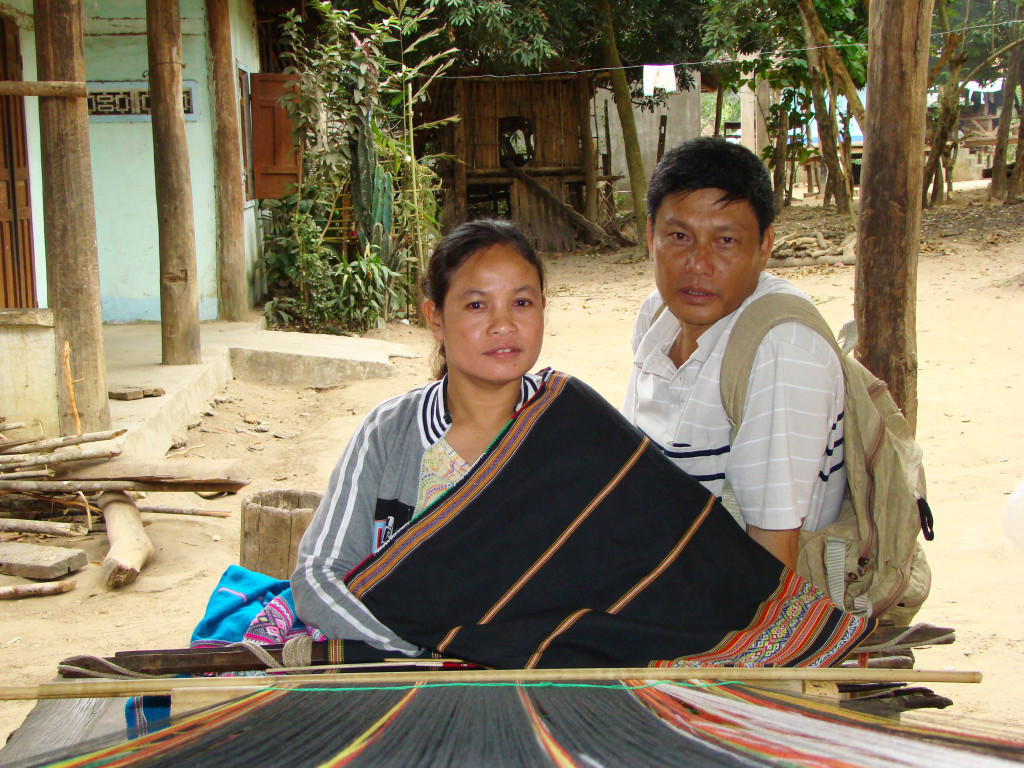Visiting the Rong House in Vietnam’s Highlands
Our translator, Mr. Vinh, smiles proudly as we arrived at his small village an hour outside the city of Kontum in Vietnam’s Central Highlands. The Bahnar village is nestled in a lush copse near the river; large leaved trees protect us from the harsh, hot sun. The ground is packed dirt, and the dogs, pigs and children wander freely between the small homes that alternate thatched and corrugated metal roofing.
First we visit Mr. Vinh’s adopted daughter, a talented weaver who has a physical disability. She sits under a shaded porch at her loom, a beautiful long cotton shawl half-created in front of her. Mr. Vinh points out the modifications of the loom that allows his daughter to fold her awkward legs under but positions her to fully operate the loom’s complexities. “She has such talent,” he beams. “I had a special loom made so she can work even if her legs won’t.”
“Now you must see our village’s Rong House.” I must have misheard him – “We’re going to the wrong house?” “Our communal house,” he clarifies. “The place where our village gathers and celebrates.”
The immense thatched-roof structure in the village’s center couldn’t be missed. Rong houses are shaped like thick axe blades, with steep-sloped sides and a long sharp ridgeline up to 50 feet off the ground that is decorated with buffalo horns or other ornaments. The building is rooted to the ground with nine thick hardwood logs that lift the 30’ x 15’ bamboo floor about five feet off the ground. A five-step ladder carved from a tree trunk invites us up to the entrance. Some Rong houses have a low railing and open sides to let the warm jungle breeze flow right through; this Bahnar Rong house has tight-fitting bamboo walls fully enclosing the open space, leaving the interior dark and, by afternoon, pretty steamy.
Both in and outside some Rong houses (and other community houses in Laos), village artists have carved wooden animal figures both into of the wooden structure’s frame or as stand-alone decorations – sculptures of birds, monkeys, eight-pointed stars, the sun and humans. The carvings symbolize myths of ancient deeds and spirits as well as daily village and farm life. Some of the figures are brightly painted. A large two-sided drum hangs from an animal-hide strap ready to call the villagers to an event or meeting. Tucked into a back corner are brass gongs, crossbows, ceremonial shields, clay flasks of wine, and other ritual wares awaiting their next use. A large flat-stoned fire-pit, used for ritual cooking as well as lighting up the town’s faces as an evening story is told, dominates the middle of the room. The house itself contains no metal. Joins are cut very carefully and the bamboo scaffolding and thatched grass for the roof are tied with strips of rattan.
Mr. Vinh points to a painted line that goes down the length of the interior. He waved his hands to the right: “The unmarried men and boys are on this side,” he announces, and with a wave to the left, “the unmarried women and girls on this side.” Then he squints his eyes a little and lowers his voice. “Sometimes a girl goes over to be with a boy on the boys’ side, but the boys can never go to the girls’ side.” I swear I catch him winking at me. Mr. Vinh suddenly straightens up: “We have a big Rong house, because our village has good land and many people. The taller the Rong house, the more powerful the men of the village, and the easier it is to find the village when hunting or farming away from town, as the tall roof can be seen from some distance. Some villages have small Rong houses. But no matter – every Rong house is the heart of a village – the place where the seasons, and births, and marriages, and even death is celebrated.”
In our visits to several ethnic groups in the Central Highlands – Bahnar, Sedang, Jarai and others – we find Rong houses of similar design and pride. Some groups build two community houses – one for the men, another for women. Regardless, the Rong house embodies the blood, sweat, tears, pride and past of the village members and their ageless ancestors; it is the physical center for a village’s heritage, power, and future. Tradition holds that a human soul only becomes whole when it joins the village soul, and the Rong house is where the members of a village and the spirits of the ancestors and nature come to respect and negotiate a proper balance.






